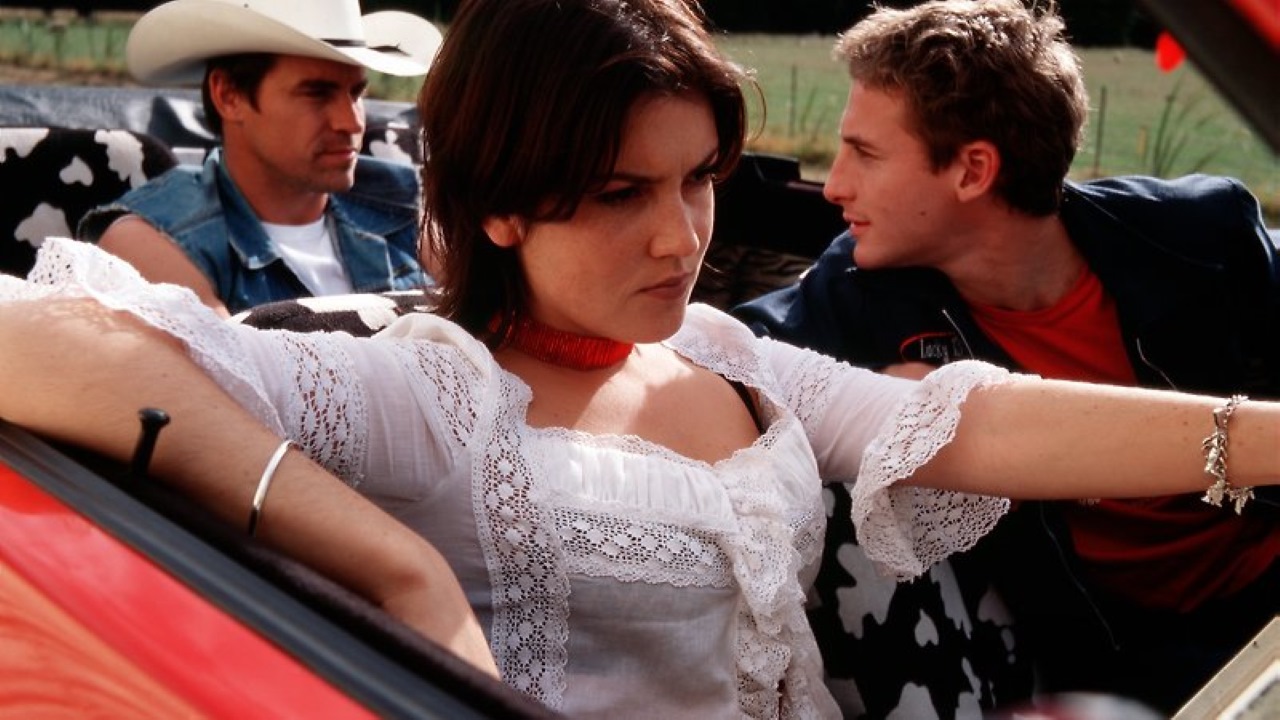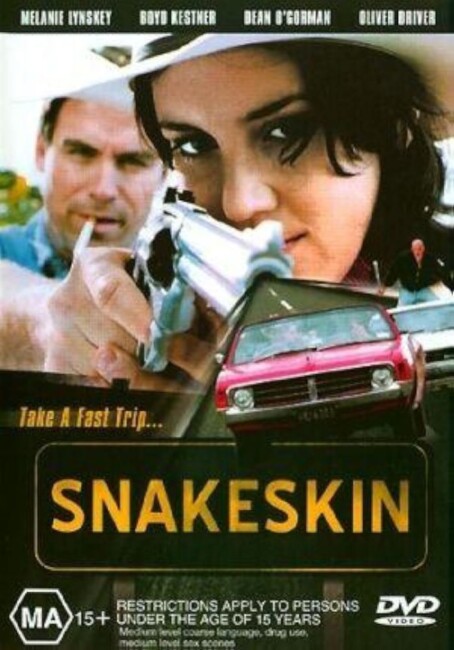Crew
Director/Screenplay – Gillian Ashurst, Producer – Vanessa Sheldrick, Photography – Donald Duncan, Music – .Leyton and Joost, Production Design – Ashley Turner. Production Company – The New Zealand Film Commission/Portman Entertainment/NZ On Air/Film 2/Cowgirl Productions.
Cast
Melanie Lynskey (Alice), Boyd Kestner (Seth), Dean O’Gorman (Johnny/Craig), Oliver Driver (Speed), Paul Glover (Terry), Charlie Bleakley (Owen), Jodie Rimmer (Daisy), Taska Cohen (Nelson), Gordon Hatfield (Tama)
Plot
Alice is bored living in rural New Zealand where nothing interesting ever happens. She dreams of an American-styled movie adventure with guns, outlaws, robbery and driving across the wide-open spaces where “there’s an adventure waiting around every corner.” She sets out on an adventure with Craig, a guy who has a crush on her and who she insists on calling Johnny, in the Valiant convertible that he has reconditioned. They pick up an American hitchhiker Seth who Alice immediately desires because he seems the real article. Out on the road, it becomes apparent that Seth is being pursued by both a gang of skinheads who want to kill him and two drug dealers in an ice cream truck wanting back the drug money that he has stolen.
This New Zealand-made production is an entry in the mini-genre of what one might term the “fucked-up road movie.” It joins films like Wild at Heart (1990), Thelma and Louise (1991), Kalifornia (1993), Natural Born Killers (1994), Butterfly Kiss (1995) and The Doom Generation (1995). These are films that invert the classic thrust of a road movie. Whereas the road movie traditionally concerns characters embarking on a journey of self-discovery, where the wide-open spaces represent the unlimited possibilities open to them, the “fucked-up road movie” represents a journey through a societal headspace that is filled with the bizarre and/or gone to hell.
Snakeskin is a surreal road movie with a particular New Zealand spin. If the aforementioned road movies represent a traditional road movie through a world gone askew, then Snakeskin is a road movie that takes a journey through semiotic space. This is the particular brilliance of the film, for what we have is a road movie that is about the iconography of the American road movie and the dream it represents. In the opening narration, Melanie Lynskey tells us: “Clint Eastwood taught me right from wrong. I didn’t go to any church but I saw a big screen movie every week. My first role model was Princess Leia, my second and third were Thelma and Louise. I wish so much my life would be like one of those Hollywood movies – a life on the road with a new adventure around every corner.”
The film comes chock full with quotes from American pop culture and films – Elvis, the Marlboro Man and The Dukes of Hazzard (1979-85), the car has little statuettes of Elvis and Marilyn Monroe on the dashboard seemingly as patron saints, while the title itself is a reference to Nicolas Cage’s snakeskin jacket in Wild at Heart. With amusing incongruity, Melanie Lynskey is constantly referring to the tranquil South Island countryside as ‘badlands’ and her automatic thought when pulling up to a gas station is to indulge fantasies about robbing it. There is even a series of jokes throughout about the quintessential New Zealand pop icon and road movie Goodbye Pork Pie (1980).

Later, in another voiceover, Melanie Lynskey puts her finger on the heart of the difference between placid New Zealand and the American pop culture images of the road movie: “… Just so we could go out driving and pretend we were on Route 66. This wasn’t easy because we lived in New Zealand. There were no scorpions and no snakes, no gangsters, and people didn’t carry handguns. It seemed to me like the safest fucking country in the world and I hated it.” As someone who grew up in New Zealand, I know only too well the aching difference between the dull uneventful ordinariness of life at hand, and the immense thrill and excitement of the adventure beyond the visible horizon as offered by Hollywood. Opening with such startling metaphorical contrasts between cinematic iconography and the banality of rural life in a country that seems entirely like one overgrown smalltown, Snakeskin seems one of the most promising and challenging of all New Zealand films.
Alas, Snakeskin seems far more exciting in what it promises to be than in anything it ends up delivering. It is as though director/writer Gillian Ashurst had spent all her conceptual effort on the striking cultural contrasts the opening offers and then dialled the rest in on autopilot. There are some occasionally surreal visions – a field of dancing sunflowers, Boyd Kestner’s cowboy who for some reasons has a tattoo that keeps moving, while later he develops snake eyes and at the end inexplicably transforms into a snake. There is a mildly risqué scene where Boyd Kestner and Melanie Lynskey have sex in a toilet cubicle and one whacked-out moment where skinhead Oliver Driver is suddenly shown jerking off dressed in a slip.
However, in comparison to say the disturbingly surreal imagery and both the heated and menacing sexuality in its nearest Hollywood counterpart, David Lynch’s Wild at Heart, Snakeskin seems tame to the point of being banal and even dull. The conceptual excitement of the opening scenes gradually dissipates into an ordinary plot with people chasing each other around the countryside. The film ends with the Melanie Lynskey’s banally underwhelming realisation that her great dreams of the American road movie were just a girlish illusion and it is time to grow up. Quite what all the snake eyes and mobile tattoos have to do with this could be anybody’s guess.
Certainly, as a vehicle designed to showcase 23-year-old New Zealand actress Melanie Lynskey, who came to prominence in Peter Jackson’s Heavenly Creatures (1994) and since went onto various roles in the US, it is an opportunity that she takes to shine with genuine star quality.


